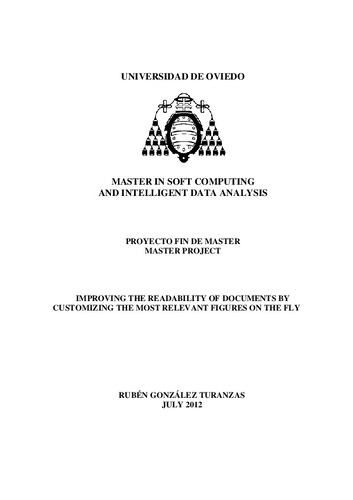Improving the readability of documents by customizing the most relevant figures on the fly
Autor(es) y otros:
Director(es):
Palabra(s) clave:
Soft Computing
Computer Vision
Readability
Clustering
Fecha de publicación:
Serie:
Máster Universitario en Soft Computing y Análisis Inteligente de Datos
Resumen:
This project was motivated for the increasing use of the small screen devices, such as smartphones, and the fact that technological advances seem to lead to a future where the digital contents will dominate over other media. Reading contents in small screen devices has drawbacks related with visual capabilities, size and reading comprehension. Inside this work, references for papers in those subjects can be found but there are no works that study the whole problem together. Probably because it is a challenge not tackled yet, there isn’t a practical solution which can improve the readability of documents by customizing them depending on the visual capabilities of the user. The proposal of this work will face the challenge using different soft computing techniques of clustering in order to compare results. Hierarchical agglomerative, K-means, multivariate Gaussian mixture models and fuzzy K-means clustering, with several variations, will be experimented in eleven text documents. The datasets obtained from the documents were extracted following a methodology that exploits techniques of mathematical morphology and statistics. Accordingly, the data will be clustered to three classes that symbolise the three basic zooms for the reading process: standard zoom, zoom for small element and zoom for large elements, all customizable by the user. The percentage of success reached for some of the techniques regarding the clustered error rate is quite high (mean near to 84%) and encouraging this researcher to continue working in the future with practical applications in the digital devices involved in the current daily life.
This project was motivated for the increasing use of the small screen devices, such as smartphones, and the fact that technological advances seem to lead to a future where the digital contents will dominate over other media. Reading contents in small screen devices has drawbacks related with visual capabilities, size and reading comprehension. Inside this work, references for papers in those subjects can be found but there are no works that study the whole problem together. Probably because it is a challenge not tackled yet, there isn’t a practical solution which can improve the readability of documents by customizing them depending on the visual capabilities of the user. The proposal of this work will face the challenge using different soft computing techniques of clustering in order to compare results. Hierarchical agglomerative, K-means, multivariate Gaussian mixture models and fuzzy K-means clustering, with several variations, will be experimented in eleven text documents. The datasets obtained from the documents were extracted following a methodology that exploits techniques of mathematical morphology and statistics. Accordingly, the data will be clustered to three classes that symbolise the three basic zooms for the reading process: standard zoom, zoom for small element and zoom for large elements, all customizable by the user. The percentage of success reached for some of the techniques regarding the clustered error rate is quite high (mean near to 84%) and encouraging this researcher to continue working in the future with practical applications in the digital devices involved in the current daily life.
Colecciones
- Trabajos Fin de Máster [5290]
Ficheros en el ítem





